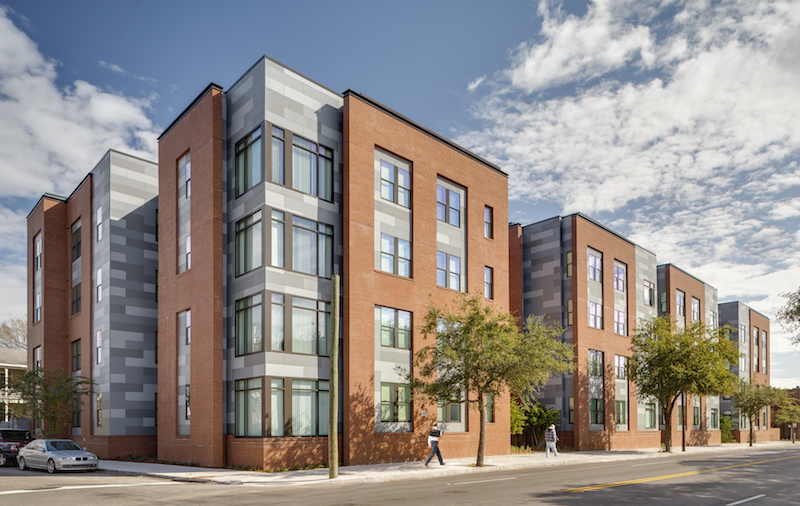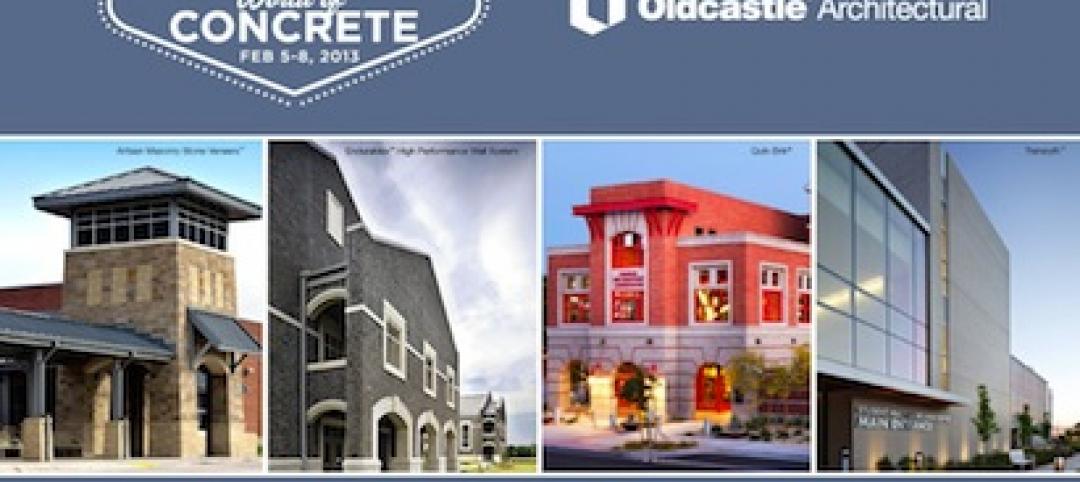Codes and design guidelines are a challenge for any project, but building a project in a historical area makes that challenge even more difficult. Add to that a project with a new façade product never before used in the jurisdiction. This was the recipe for 400 Meeting Street Apartments in downtown Charleston, S.C. Known for its history and historic architecture, the Charleston Board of Architectural Review takes its job maintaining the integrity of local architecture seriously.
The team chose Nichiha Illumination panels for this building’s façade. Fiber cement is a great addition on student housing projects because these projects typically feature tight budgets and need products with good longevity, says Stuart Barber, AIA, LEED-AP, project architect, McMillan Pazdan Smith Architecture, Charleston, S.C.
Because the BAR wasn’t familiar with Nichiha fiber cement panels, the team explained the benefits of the product for this building. In addition, the team wanted to build a modern structure in a historic area, adding to importance of explaining how Nichiha best fit that desire. “We had to inform them that this new material and the building played a role in historic settings like Charleston,” Barber says.
Fiber cement cladding has become an effective and cost efficient alternative to wood siding in downtown Charleston. “The Illumination panels build on this base by taking this material and using it in a more contemporary way with larger panels and seamed connections rather than trimmed connections,” Barber adds.
The panel installers, Premier Exteriors, Ridgeland, S.C. were asked to create three wall mockups for the BAR. “I give kudos to the team who handled the review board process. The first time I saw the design, I wasn’t sure it would get approved by the BAR because the requirements are so rigorous [due to the historic preservation needs of buildings in the area],” says David Winters, branch manager for Charleston Division, Premier Exteriors.
The neighboring buildings were also new construction, which helped in the design flexibility of this project. In addition, the fact that it was a student housing building also lent itself to a bit more design creativity, Barber adds.
The project includes three shades of gray Nichiha Illuminations architectural wall panels that are laid out to appear like a checkerboard. The checkerboard design was chosen to enhance the building’s contemporary architecture.
The design and the need to use three different colors was a challenge for the installation team. “Once we realized the intention for the design, it was easier to lay out. For example, we figured out the architect wanted 50 percent of one color, 25 percent of another, and 25 percent of the third color,” Winters says. “This project made us think on our feet.” The building ended up using 23,000 sq. ft. of Nichiha Illumination architectural wall panels in the three gray colors that delivered a modern appearance.
This area of South Carolina experienced a large amount of rain at the time of installation affecting the building’s stability. In addition, the state’s damp environment made the building’s wood construction shift, as is often the case with wood-built structures in this region. This shift affected the panel installation, because now the walls were no longer level. To accommodate this challenge, Nichiha offered shims to level the walls, which was a key component to installing the panels.
In the end, both the architect and installation team are proud of the end result. “The Illumination panels offered a new way of using an established material like fiber cement,” Barber says. “When it’s detailed correctly, it can be appropriate in any number of applications, especially in historical settings.”
This project showed the BAR that this design and material choice can complement historical design. In fact, this project opened the door for several more projects in the area with Nichiha fiber cement cladding. In addition, because Charleston is an area with a strong architecture community and a lot of architecture firms, the use of Architectural Wall Panels in the area allows this influential community to literally see how well the product complements new and old buildings in such a historical setting.
Challenge
Located in historic downtown Charleston, S.C., the architect had to get approval from the Board of Architectural Review to use a new, contemporary façade material in this project. In addition, the state’s damp environment made the building’s wood construction shift, as is often the case with wood-built structures in this region.
Solution
Three wall mockups plus education allowed the BAR to approve the use of Nichiha Illumination architectural wall panels. Nichiha provided shims to correct the wall shifting due to the areas environmental conditions. This allowed the panels to be installed correctly.
Results
Complementing the historic area that is downtown Charleston, a 40-unit building was built in the heart of downtown. Featuring a stunning checkerboard design in three shades of gray, the building set an example of how Nichiha fiber cement meets modern and traditional design. This project was such a success that it lead the way for more projects in the area with Nichiha fiber cement siding.

400 Meeting Street Apartments located in Charleston, SC.
PROJECT DETAILS:
Case Study: 400 Meeting Street Apartments, Charleston, S.C.
Architect: McMillan Pazdan Smith Architecture
Installer: Premier Exteriors LLC
Location: Charleston, S.C.
Product: Illumination Panels
Related Stories
| Aug 22, 2013
Energy-efficient glazing technology [AIA Course]
This course discuses the latest technological advances in glazing, which make possible ever more efficient enclosures with ever greater glazed area.
| Jul 1, 2013
Firestone Building Products Company LLC Announces Sustainability Report
Firestone Building Products Company, LLC, the leading manufacturer of superior “Roots to Rooftops” products for commercial building performance solutions, today announced the release of its 2012 Sustainability Report. The report, the first for Firestone Building Products Company, covers the fiscal 2012 year and is available for download at firestonebpco.com.
| Jun 28, 2013
Calculating the ROI of building enclosure commissioning
A researcher at Lawrence Berkeley National Laboratory calls building enclosure commissioning “the single-most cost-effective strategy for reducing energy, costs, and greenhouse gas emissions in buildings today.”
| May 14, 2013
Easy net-zero energy buildings [infographic]
"Be a Zero Hero" infographic educates building industry professionals on ultra energy-efficient structural insulated panel construction
| Apr 30, 2013
First look: North America's tallest wooden building
The Wood Innovation Design Center (WIDC), Prince George, British Columbia, will exhibit wood as a sustainable building material widely availablearound the globe, and aims to improve the local lumber economy while standing as a testament to new construction possibilities.
| Apr 16, 2013
5 projects that profited from insulated metal panels
From an orchid-shaped visitor center to California’s largest public works project, each of these projects benefited from IMP technology.
| Apr 8, 2013
Oldcastle Architectural acquires Expocrete Concrete Products
Oldcastle® Architectural has acquired Expocrete Concrete Products Ltd., giving North America’s largest producer of concrete masonry and hardscape products an increased presence in the high-growth region of western Canada.
| Apr 8, 2013
Most daylight harvesting schemes fall short of performance goals, says study
Analysis of daylighting control systems in 20 office and public spaces shows that while the automatic daylighting harvesting schemes are helping to reduce lighting energy, most are not achieving optimal performance, according to a new study by the Energy Center of Wisconsin.
| Apr 3, 2013
AIA CES class: Sealant repairs that last – hybrid sealants for building restoration
It is hard to talk about restoration without talking about sustainability. This two-hour interactive online course discusses the role that restoration can and does play in the arena of sustainability, and specifically the role that sealants play in sustainable design and repair.
| Mar 27, 2013
Small but mighty: Berkeley public library’s net-zero gem
The Building Team for Berkeley, Calif.’s new 9,500-sf West Branch library aims to achieve net-zero—and possibly net-positive—energy performance with the help of clever passive design techniques.

















